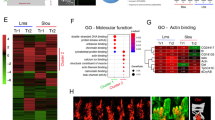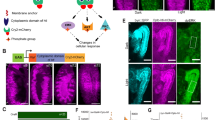Abstract
The Drosophila melanogaster gene Anaplastic lymphoma kinase (Alk) is homologous to mammalian Alk, a member of the Alk/Ltk family of receptor tyrosine kinases (RTKs)1. We have previously shown that the Drosophila Alk RTK is crucial for visceral mesoderm development during early embryogenesis2. Notably, observed Alk visceral mesoderm defects are highly reminiscent of the phenotype reported for the secreted molecule Jelly belly (Jeb)3. Here we show that Drosophila Alk is the receptor for Jeb in the developing visceral mesoderm, and that Jeb binding stimulates an Alk-driven, extracellular signal-regulated kinase-mediated signalling pathway, which results in the expression of the downstream gene duf (also known as kirre)4,5—needed for muscle fusion. This new signal transduction pathway drives specification of the muscle founder cells, and the regulation of Duf expression by the Drosophila Alk RTK explains the visceral-mesoderm-specific muscle fusion defects observed in both Alk and jeb mutant animals.
This is a preview of subscription content, access via your institution
Access options
Subscribe to this journal
Receive 51 print issues and online access
$199.00 per year
only $3.90 per issue
Buy this article
- Purchase on Springer Link
- Instant access to full article PDF
Prices may be subject to local taxes which are calculated during checkout




Similar content being viewed by others
References
Loren, C. E. et al. Identification and characterization of DAlk: a novel Drosophila melanogaster RTK which drives ERK activation in vivo. Genes Cells 6, 531–544 (2001)
Loren, C. E. et al. A crucial role for the Anaplastic lymphoma kinase receptor tyrosine kinase in gut development in Drosophila melanogaster. EMBO Rep. 4, 781–786 (2003)
Weiss, J. B., Suyama, K. L., Lee, H. H. & Scott, M. P. Jelly belly: a Drosophila LDL receptor repeat-containing signal required for mesoderm migration and differentiation. Cell 107, 387–398 (2001)
Ruiz-Gomez, M., Coutts, N., Price, A., Taylor, M. V. & Bate, M. Drosophila dumbfounded: a myoblast attractant essential for fusion. Cell 102, 189–198 (2000)
Strunkelnberg, M. et al. rst and its paralogue kirre act redundantly during embryonic muscle development in Drosophila. Development 128, 4229–4239 (2001)
Fujimoto, J. et al. Characterization of the transforming activity of p80, a hyperphosphorylated protein in a Ki-1 lymphoma cell line with chromosomal translocation t(2;5). Proc. Natl Acad. Sci. USA 93, 4181–4186 (1996)
Morris, S. W. et al. Fusion of a kinase gene, ALK, to a nucleolar protein gene, NPM, in non-Hodgkin's lymphoma. Science 263, 1281–1284 (1994)
Falini, B. Anaplastic large cell lymphoma: pathological, molecular and clinical features. Br. J. Haematol. 114, 741–760 (2001)
Duyster, J., Bai, R. Y. & Morris, S. W. Translocations involving anaplastic lymphoma kinase (ALK). Oncogene 20, 5623–5637 (2001)
Morris, S. W. et al. ALK, the chromosome 2 gene locus altered by the t(2;5) in non-Hodgkin's lymphoma, encodes a novel neural receptor tyrosine kinase that is highly related to leukocyte tyrosine kinase (LTK). Oncogene 14, 2175–2188 (1997)
Iwahara, T. et al. Molecular characterization of ALK, a receptor tyrosine kinase expressed specifically in the nervous system. Oncogene 14, 439–449 (1997)
Klapper, R. et al. The formation of syncytia within the visceral musculature of the Drosophila midgut is dependent on duf, sns and mbc. Mech. Dev. 110, 85–96 (2002)
Martin, B. S., Ruiz-Gomez, M., Landgraf, M. & Bate, M. A distinct set of founders and fusion-competent myoblasts make visceral muscles in the Drosophila embryo. Development 128, 3331–3338 (2001)
Dworak, H. A. & Sink, H. Myoblast fusion in Drosophila. Bioessays 24, 591–601 (2002)
Baylies, M. K. & Michelson, A. M. Invertebrate myogenesis: looking back to the future of muscle development. Curr. Opin. Genet. Dev. 11, 431–439 (2001)
Bate, M. The embryonic development of larval muscles in Drosophila. Development 110, 791–804 (1990)
Carmena, A., Bate, M. & Jimenez, F. Lethal of scute, a proneural gene, participates in the specification of muscle progenitors during Drosophila embryogenesis. Genes Dev. 9, 2373–2383 (1995)
Gabay, L., Seger, R. & Shilo, B. Z. MAP kinase in situ activation atlas during Drosophila embryogenesis. Development 124, 3535–3541 (1997)
Patel, N. H. Imaging neuronal subsets and other cell types in whole-mount Drosophila embryos and larvae using antibody probes. Methods Cell Biol. 44, 445–487 (1994)
Campos-Ortega, J. A. & Hartenstein, V. The Embryonic Development of Drosophila Melanogaster. (Springer, Berlin, 1997)
Palmer, R. H. et al. DFak56 is a novel Drosophila melanogaster focal adhesion kinase. J. Biol. Chem. 274, 35621–35629 (1999)
Jiang, W. et al. PRC1: a human mitotic spindle-associated CDK substrate protein required for cytokinesis. Mol. Cell 2, 877–885 (1998)
Kopczynski, C. C., Davis, G. W. & Goodman, C. S. A neural tetraspanin, encoded by late bloomer, that facilitates synapse formation. Science 271, 1867–1870 (1996)
Acknowledgements
The authors would like to thank T. Hunter and I. Salecker for critical reading of the manuscript, and D. Eriksson, N. Norgren and A. Sheikholvaezin for help with ELISA analysis. This work is funded by the Swedish Research Council and is also supported by The Swedish Society for Medical Research (SSMF), Åke Wibergs Fund, the Royal Swedish Academy of Sciences, Lars Hiertas Minne Fund, and the Cancer Research Fund of Northern Sweden. F.D. was supported by a post-doctoral fellowship from the Wenner-Grenska Foundation.
Author information
Authors and Affiliations
Corresponding author
Ethics declarations
Competing interests
The authors declare that they have no competing financial interests.
Rights and permissions
About this article
Cite this article
Englund, C., Lorén, C., Grabbe, C. et al. Jeb signals through the Alk receptor tyrosine kinase to drive visceral muscle fusion. Nature 425, 512–516 (2003). https://doi.org/10.1038/nature01950
Received:
Accepted:
Issue Date:
DOI: https://doi.org/10.1038/nature01950
This article is cited by
-
Analysis of the prognostic value of uric acid on the efficacy of immunotherapy in patients with primary liver cancer
Clinical and Translational Oncology (2023)
-
Placing human gene families into their evolutionary context
Human Genomics (2022)
-
Structural basis of cytokine-mediated activation of ALK family receptors
Nature (2021)
-
Structural basis for ligand reception by anaplastic lymphoma kinase
Nature (2021)
-
Aberrant role of ALK in tau proteinopathy through autophagosomal dysregulation
Molecular Psychiatry (2021)
Comments
By submitting a comment you agree to abide by our Terms and Community Guidelines. If you find something abusive or that does not comply with our terms or guidelines please flag it as inappropriate.



